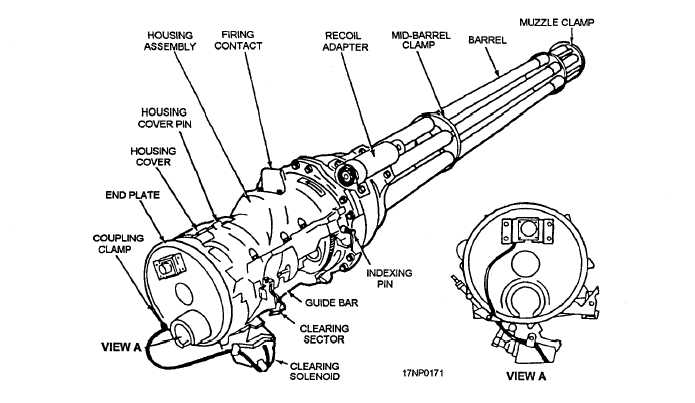Figure 6-3.—Gun component locations.
Barrels. The M61A1 automatic gun has six rifled
barrels. They are supported by the stub rotor attached
to the rotor body. The three rows of interrupted locking
lugs on the barrel engage similar interrupted locking
lugs in the rotor to secure the barrel. There are three
knurled bands near the center of the barrels. These
bands give you a gripping surface for easy installation
and removal of the barrels from the rotor.
Recoil adapters. The recoil adapters are mounted
on the bearing retainer and provide the front mounting
for the gun. There are alternate locations for the recoil
adapters with respect to the gun’s axis. These locations
are possible because the bearing retainers can be
mounted to the housing in increments of 60 degrees.
The adapters reduce the amount of recoil and
counter-recoil forces transmitted to the supporting
structure when the weapon is fired.
Firing contact assembly. The firing contact
assembly is mounted to the housing so that the connector
is outside the housing, and the spring-loaded cam is
inside the assembly. The contact assembly provides the
necessary path for the current to enter the housing and
reach the breech-bolt assembly. This path goes through
the connector to the conductor, to the insulated insert in
the contact cam assembly, and then to the breech-bolt
assembly.
Clearing solenoid assembly. The clearing
solenoid assembly is mounted near the back of the gun
housing. It is linked to and controls the movement of
the clearing sector assembly.
Clearing sector assembly. The clearing sector
assembly is linked to and controlled by the clearing
solenoid assembly. When the solenoid is activated, the
sector arm diverts the bolt assemblies into the clearing
cam path.
Guide bar. The guide bar is located on the gun
housing. It guides the rounds into and out of the
extractor lip that is located on each of the six breech-bolt
assemblies.
Breech-bolt assembly. The breech-bolt assembly
picks up a round as it enters the gun, transports it to the
firing chamber, locks it into the firing position, transmits
the firing voltage to the primer of the round, and returns
the empty case to the guide bar, where it is cammed out
of the gun. An extractor lip on the front of each bolt
assembly engages the rim of a round throughout these
actions.
There are six breech-bolt assemblies in the gun.
Guide slots or grooves on the side of the bolt body
permit it to slide on the rotor tracks. The bolt roller shaft
determines the position of the bolt as it follows the main
cam path or the clearing cam path in the housing.
6-3


